Evidence explains why 'Limiting social exposure' is an extremely important step to saving the world from the Covid-19 pandemic
At the end of World War I, there was a terrible epidemic spread to the world, called "Spanish flu". The disease has infected more than a quarter of the world's population, an estimated 50 to 100 million deaths, and is also one of the deadliest pandemics in human history.
Amid the pandemic, cities in the US have had mixed reactions. In September 1918, a number of places planned a march to promote free bonds, which were sold to help fund the cost of war in Europe. In Philadelphia (Pennsylvania) - where there were already 600 soldiers infected with the flu virus, the city government still decided to conduct this event. Meanwhile, the city of St. Louis (Missouri) canceled, and issued a request to limit public gatherings around the city.
1 month later, Philadelphia had 10,000 deaths, while in St. Louis has only 700 victims.
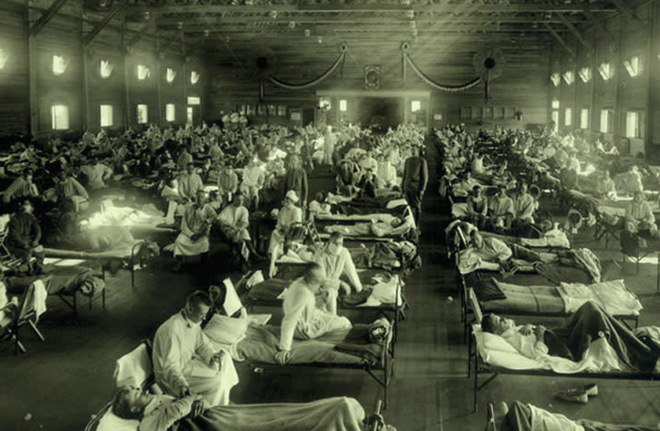
The importance of "Social spacing" in epidemics
The parade was not the only reason why the death rates between the two cities were so different. That data essentially speaks to the importance of the so-called "social gap" - or "social distancing" - during a pandemic.
"Social spacing means creating a distance with 2 or more others, to prevent or reduce the likelihood of the virus spreading," - quoted Arindam Basu, associate professor of epidemiology and environmental health at the University of Canterbury, New Zealand.

A study published in the scientific journal PNAS analyzed the situation of a number of American cities in 1918, showing that the places where banning gatherings, closing theaters, schools and churches were early recorded were The mortality rate is much lower.
Over the past 100 years, the world has faced another pandemic: Covid-19 from the corona virus SARS-CoV-2. Today, the world's population is larger than 1918 to 6 billion. But while Covid-19 is different from Spanish flu - both in terms of definition and mortality, the lesson of limiting social exposure is still really important. Because this may be the best measure at the moment to combat a global pandemic.
"At present, we do not have a vaccine that is safe and effective, and we do not know what is a good cure for Covid-19," - Basu said. "Without both of these things, the best option for us now is prevention."
Limit social contact other than isolation
Many countries around the world are currently testing a number of measures to apply social spacing to slow the spread of Covid-19. From preventing crowds, closing public places, entertainment centers, bars, pubs, schools . to blockade the whole city and force people to stay indoors.
Home self-isolation that many people at risk of infection is also a form of social separation, but there are still differences that need to be clarified. "Quarantine" is a term used to prevent people who have been identified from infection or have been exposed to germs from spreading. And "social gap" is a measure applied more widely to all subjects, to minimize the possibility of disease spread to the community.
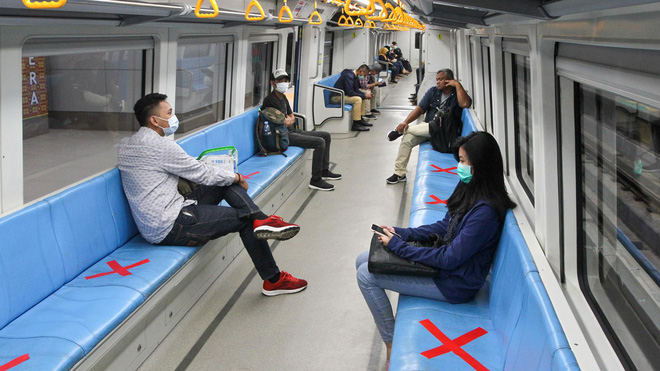
Social isolation is applied on public transport - each person is a safe distance away
And there are reasons for us to believe that keeping social distance will be an important strategy for the current Covid-19 pandemic.
According to an unpublished study published on the CMMID (Center for Mathematical Models of Infectious Diseases), an average person infected with coronavirus can infect 2-3 people at the beginning of the disease. The incubation period - from exposure to symptoms - usually lasts for 5 days, possibly up to 14 days - according to research from China.
Due to the long incubation period, if you are infected and continue to socialize as usual, you will infect at least 2-3 other people - be it friends or family members. These people continue to spread, and as a result, in 1 month, at least 244 people will be infected with the virus, and in 2 months will reach 59604 - with only a single source of friends.
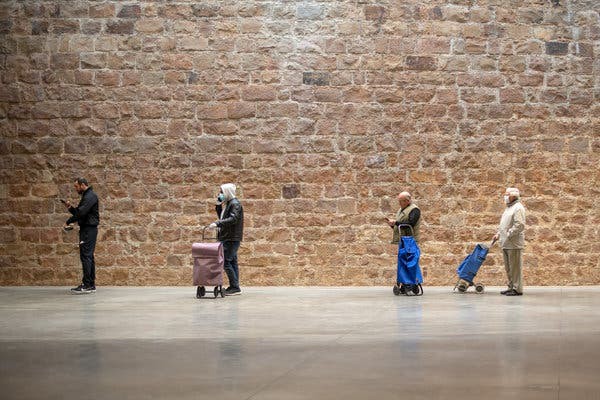
But not all! Several studies point to evidence that the new strain of corona virus can be transmitted from person to person even before the onset of symptoms - also known as the "silent infection" group. Research by expert Lauren Ancel Meyers from the University of Texas, Austin, shows that this group can account for up to 10% of current infections. In addition, an estimated 1% - 3% of infected people will not exhibit symptoms. They are positive for the virus but still healthy, and of course don't know how to isolate themselves.
So if the method of "social spacing" is applied well enough, the virus will not be able to spread anymore?
Lessons from tragedies
Currently, there is much evidence that keeping the public at home, keeping a safe distance from each other can slow the spread of Covid-19. In Wuhan, researchers identified a blockade order that helped reproduce the city reproductive coefficient from 2.35 to near 1. When known, the coefficient hit 1, the number of cases. The infection will stop growing, because each person will only be able to infect 1 other person.
Modeling cases in China also shows similar results, when "social gap" is the key to reducing infection rates in Hubei province. It can be concluded that the earlier the blockade order is issued, the lesser the consequences will be.
One of the biggest goals of "social spacing" is to "flatten" trends - or simply spread the virus as slowly as possible. The idea is to extend the time it spreads to the community and push the epidemic peak as deep as possible. In doing so, the trend graph will be flatter, giving humanity more time to treat the disease, and also reduce the pressure on the health sector.

The graph shows that the 1918 Spanish flu peak increased very quickly in Philadelphia, while in St. Louis is "flatter" due to the application of social isolation
But how to put this idea into practice? Countries around the world will take different approaches. He is one of the countries that tried to predict the likelihood of the virus spreading, through a study by Imperial College London on March 16. They used two fictional models with the United Kingdom and the United States: one applied to isolate cases of infection, and one requires social separation from the community.
The results show that, without taking any measures to prevent the epidemic, Britain will face the disaster of more than 500,000 deaths, while the US is 2.2 million. If isolated from infected people is applied, the pressure on the health sector will be reduced by two-thirds and the death toll will be reduced by more than half, but this is still too much. So, the best would be the second policy - social distance.
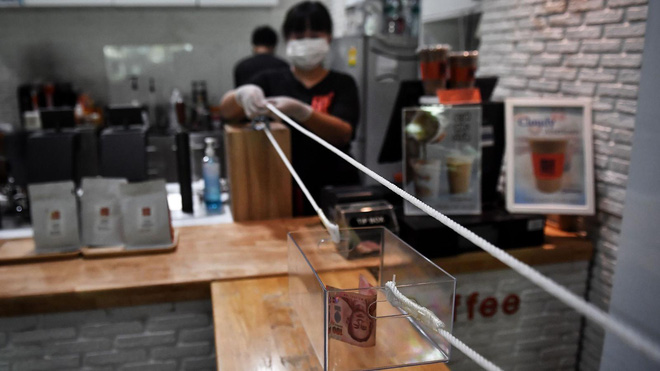
Some restaurants have devised measures to limit contact with customers
Before the report was published, the UK had taken steps to "community immunity" - that is, to spread the disease and cure it, then produce a vaccine. However, they had to reject this method because the spread of the disease was very fast, overloaded the health sector and could have serious consequences. At the same time, the British government enacted tightening measures for businesses and public places nationwide.
The present idea is another testament to the importance of keeping social distance. The boot-shaped country has an aging population, and families tend to live closer. As a result, Italy has now become the world's epidemic center and the 2nd largest outbreak globally, with the number of deaths more than 2 times higher than China. Part of the reason is also because the death rate in the elderly over the age of 80 is too high - 14.8%.
But when Italy adopted social spacing, things were still different. Try a comparison between Bergamo and Lodi - two towns that applied different measures when the disease broke out. In Lodi, the first virus infection was confirmed on February 21, and the tightening order was applied only two days later. Bergamo had its first case on February 23 in a small community, but took no action until the nationwide blockade order was issued on March 8.
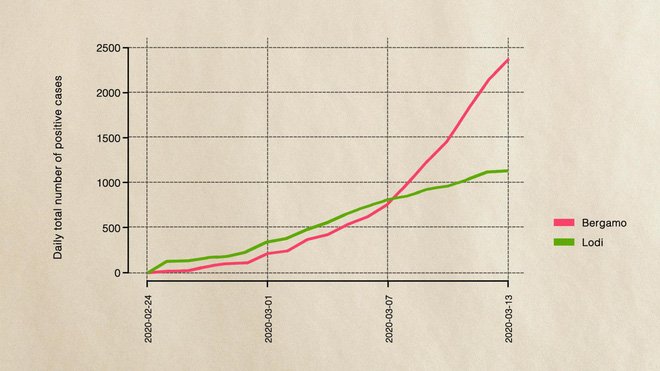
Comparison between Bergamo (red) and Lodi (blue) - two towns with different epidemic approaches
On March 7, both towns had about 800 cases. But by March 13, Bergamo had grown to 2,300 cases, while Lodi was only 1,100. Both towns share the same age structure in the population, with 21% of the elderly over 65.
"Although Bergamo is more populous than Lodi, the outbreak in both places is on the same scale and comparable," - Jennifer Dowd from Oxford University.
According to Dowd, the story of these two towns will probably be very similar to what happened to Philadelphia and St. Louis. Louis in 1918, but it is still too early to assert. Because the biggest difference is in the number of people infected, not the number of deaths.
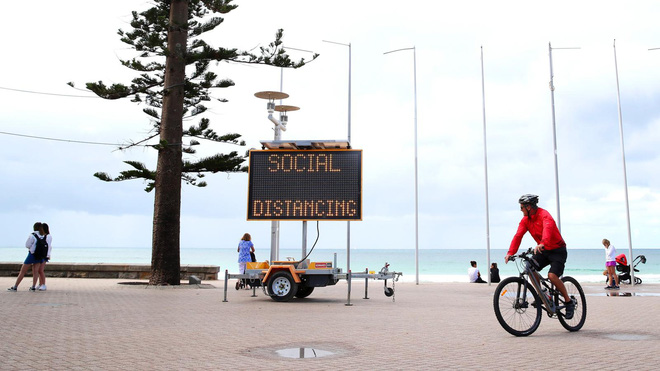
But overall, Dowd said we have sufficient evidence to conclude restricting social exposure is effective."We have seen real evidence of the effectiveness of this method."
Of course, it is not easy to keep away from the community, away from friends and family, especially in the time when the epidemic causes fear to spread. Some studies also point to the consequences of long-term community alienation, such as an increased risk of heart disease, depression, or memory loss.
However, unlike in 1918, social distance does not mean we can no longer contact each other. Today, you have enough technology - phones, computers, internet . to stay connected with relatives and friends.
And the most important thing we should do, if it helps keep the loved ones safe.
The development of COVID-19 in Vietnam is becoming more and more complex, and in the near future, our country will enter a real challenge. The message that the Government, the Ministry of Health and other local authorities issue is: People who have no duties, if really not needed should stay home because of the risk of cross-contamination among the community. Copper is very high.
Stand still for the moment - for all of us, it's at home. I am at home! I take social isolation seriously. Because at home now is protecting themselves, protecting relatives, helping reduce the risk of infection in the community, and lessening the burden on the shoulders of the Fatherland.
Doctors around the world are spreading the message "We go to work for you, please stay at home for us". As a citizen consciously, putting health safety first, let's spread the #toionha appeal to quickly push back #CeVyĐiGo guys!
Reference: BBC
You should read it
- Scientists claim that 'the other world' exists
- Worlds of 'no dead' places in the world
- 1/7 of the world population uses Google Earth
- The world's first 3D printed pedestrian bridge in Spain
- How to save the map and share the map in Mini World: Block Art
- Traffic works have 1-0-2 in the world
- 2018 World Cup schedule
- Enjoy the 2018 World Cup with Google's useful services
May be interested
- Flu epidemic in the US is unusual, surpassing the Covid-19 pandemic
 the us is experiencing a flu season that experts say is unusual, with hospitalization rates exceeding those of covid-19 during the pandemic, with many medical facilities overloaded and many patients seriously ill.
the us is experiencing a flu season that experts say is unusual, with hospitalization rates exceeding those of covid-19 during the pandemic, with many medical facilities overloaded and many patients seriously ill. - Apple donated 2 million masks to US and European health care to assist in coping with the Covid-19 pandemic
 prior to this beautiful act, the vice president of the united states called on other companies to study apple and actively donate to local health facilities to jointly fight the covid-19 pandemic.
prior to this beautiful act, the vice president of the united states called on other companies to study apple and actively donate to local health facilities to jointly fight the covid-19 pandemic. - The Math behind Covid-19 Translation: Why is it necessary to keep social distance, avoid gathering?
 as with many other epidemics in the past, it is likely that we will reach a peak in covid-19, after which, new infections will begin to diminish until r0 drops below 1 and the epidemic will however, the important thing we need to do is to do a combination of measures
as with many other epidemics in the past, it is likely that we will reach a peak in covid-19, after which, new infections will begin to diminish until r0 drops below 1 and the epidemic will however, the important thing we need to do is to do a combination of measures - Korea's supply chain faces unprecedented chaos due to the Covid-19 pandemic
 the chaos in korea's supply chain is entirely understandable in the context of the extremely raging covid-19 epidemic in china and south korea.
the chaos in korea's supply chain is entirely understandable in the context of the extremely raging covid-19 epidemic in china and south korea. - Did the Covid-19 pandemic collapse the global Internet system? Professor Harvard answered
 covid-19 is upsetting the lives of many people in the world, about high-speed internet speed that can crash the entire global network?
covid-19 is upsetting the lives of many people in the world, about high-speed internet speed that can crash the entire global network? - The US outbreak control committee advised people to livestream the funeral to avoid the spread of Covid-19
 technology continues to be humanity's end in the pandemic.
technology continues to be humanity's end in the pandemic. - Mask reuse: Is microwave steaming safe from Covid-19 virus?
 facing the covid-19 pandemic that is threatening the world, the situation of masks becoming so scarce, is it safe to reuse? the answer was recently shared on the corona virus shield page by bs. tran van phuc (green po hospital, hanoi) launched.
facing the covid-19 pandemic that is threatening the world, the situation of masks becoming so scarce, is it safe to reuse? the answer was recently shared on the corona virus shield page by bs. tran van phuc (green po hospital, hanoi) launched. - How to refuel nuclear power plants during a pandemic?
 to replace uranium bars, hundreds of engineers across the united states worked together for weeks at a time. this work is further complicated in the context of the covid-19 pandemic that continues to spread throughout the world.
to replace uranium bars, hundreds of engineers across the united states worked together for weeks at a time. this work is further complicated in the context of the covid-19 pandemic that continues to spread throughout the world. - How to Help Children Understand Social Distancing
 like most people, you're probably worried about the covid-19 coronavirus pandemic and want to keep your family safe. fortunately, practicing social distancing is an easy way to help limit the spread of the virus so fewer people get sick....
like most people, you're probably worried about the covid-19 coronavirus pandemic and want to keep your family safe. fortunately, practicing social distancing is an easy way to help limit the spread of the virus so fewer people get sick.... - Plague Inc. prepare to launch a new free update, allowing players to save the world from a pandemic
 besides developing a new game mode, ndemic creations - the father of plague inc. also donated us $ 250,000 for the fight against covid-19.
besides developing a new game mode, ndemic creations - the father of plague inc. also donated us $ 250,000 for the fight against covid-19.










 Wuhan team: 3-10% of Covid-19 patients after discharge were positive for the virus but did not infect others.
Wuhan team: 3-10% of Covid-19 patients after discharge were positive for the virus but did not infect others. Japan introduces new prototype super speed train: Using wireless charging technology, reaching a maximum speed of over 500km / h
Japan introduces new prototype super speed train: Using wireless charging technology, reaching a maximum speed of over 500km / h See this series of aerial photos to see how the world has changed dramatically because of COVID-19
See this series of aerial photos to see how the world has changed dramatically because of COVID-19 The artificial neural network found that antibiotics kill bacteria that every other drug has to give up, posing more difficult questions for science
The artificial neural network found that antibiotics kill bacteria that every other drug has to give up, posing more difficult questions for science Mitsubishi Heavy Industries ZSX - New generation 'air conditioner'
Mitsubishi Heavy Industries ZSX - New generation 'air conditioner' Scientific research: Life can exist in many places in the Universe, it is not only in the region we can observe.
Scientific research: Life can exist in many places in the Universe, it is not only in the region we can observe.